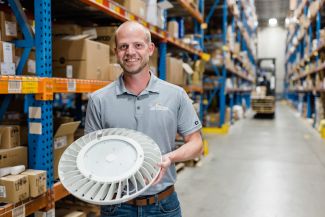How To Extend The Lifetime Of Your Led Fixture
- July 18, 2024
- Best Practices
- Lighting
 Let’s say you just purchased a brand-new LED television set. Would you install it over hot steel? What about acids or paints? How about in an area that’s extremely cold… or extremely hot? Besides the fact that you likely won’t want to watch TV in those extreme environments – it’s common sense to assume the TV wouldn’t operate quite right, either! The same principle applies to LED fixtures. To achieve peak performance, consider the environment where the lights are installed. What other factors should you consider to help extend the lifetime of the LED fixture?
Let’s say you just purchased a brand-new LED television set. Would you install it over hot steel? What about acids or paints? How about in an area that’s extremely cold… or extremely hot? Besides the fact that you likely won’t want to watch TV in those extreme environments – it’s common sense to assume the TV wouldn’t operate quite right, either! The same principle applies to LED fixtures. To achieve peak performance, consider the environment where the lights are installed. What other factors should you consider to help extend the lifetime of the LED fixture?
WHY DOES AN LED FIXTURE STOP WORKING?
In most cases, if an LED fails, it’s because of the driver. If you are buying new fixtures for a project, we strongly suggest purchasing either spare drivers or extra fixtures. It’s a simple process to fix the driver – just disconnect it from the power source, replace it and reconnect it.
If anything else fails on the fixture, it is likely the wiring or the LED chips themselves. Most manufacturers have integrated chip-on-board LED arrays. Because the board and the chips are so integrated, it would require a new fixture. Very few lights on the market today allow for replacing the chipboard.
If you look at your LED light and see a few burned out, know that it will not affect the overall illumination of your light. The driver can sense which chips are not operating and will increase power to the entire array to maintain lighting levels. However, if an entire board is burnt out, the fixture would need to be replaced.
HOW CAN YOU PROTECT YOUR LED FIXTURE?
LED fixtures are well known for their energy-efficiency, longevity and ease of maintenance. And, the technology continues to improve. To get the most out of your LED light, follow these tips:
1. Ensure the LED fixtures you choose are suitable for the installation location.
Most LED failures are caused by using the incorrect LED for the environment. Before you consider replacing old fixtures, especially in manufacturing environments, be sure to ask the question: Is this LED fixture the best replacement for the area? For example, a fluorescent light above an oily machine wouldn’t affect the fixture. But for an LED, the oils could harm the chipboards if they are not sealed and protected, causing it to break down.
2. Protect your LED fixture from surge damage.
Remember that LED lights are electronic devices, which means they’re much more prone to surge damage due to poor power quality. This could come from electrical noise by variable drives or machinery startups that create surges and spikes, ultimately damaging the LED fixture’s driver or chips. Be sure to have healthy surge protection modules built into your LED. Adding this protection usually involves a small cost, but it helps ensure your fixtures are not damaged and saves you money in the long term.
3. Perform minor maintenance for optimal performance.
With a traditional fluorescent light, we’re used to cleaning and dusting when replacing bulbs. But with LED lights, there’s no need to replace bulbs – so the minor cleaning is easily forgotten. Take the time to periodically clean the fixture and lenses of your LED to prevent dust buildup and loss of lumen output.
Keep in mind, LED fixtures are evolving. Manufacturers continually modify offerings and improve the technology behind their products. To future-proof your lighting systems, look for a company that values supporting the fixture for years to come. Van Meter is committed to partnering with manufacturers that value consistency and longevity. We’re here to help you find the best lighting control system to fit your environment, budget and timeline. Contact us or call 800-247-1410 to speak with a Van Meter lighting specialist today..

ARTICLE BY:
JOHN BEAUDRY
EMPLOYEE-OWNER, LIGHTING SPECIALIST